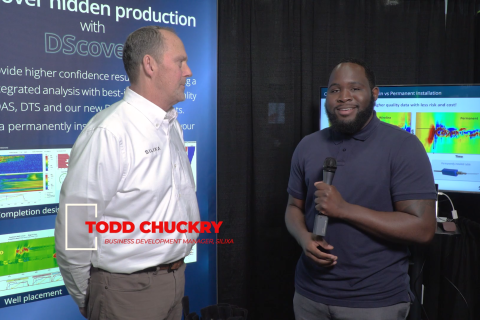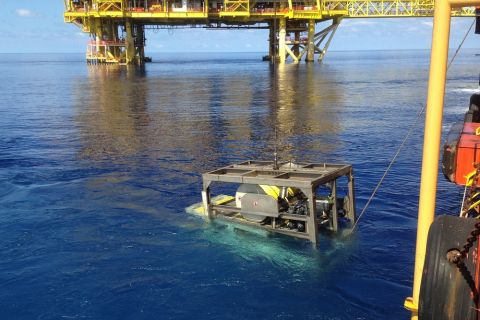
The Whale production semi heading for the Gulf of Mexico for Shell. Shell operates Whale with 60% interest on behalf of partner Chevron with 40% interest. (Source: Seatrium)
Shell’s quest for speedy development cycles in the Gulf of Mexico (GoM) has the supermajor applying brownfield thinking to greenfield developments.
The approach isn’t easy as the development activities at the outset start with different questions, Shell experts said during a May 8 panel on the Whale project during the 2024 Offshore Technology Conference (OTC) in Houston.
In the deepwater GoM, Shell is largely replicating its operated Vito production semisubmersible for the Whale and Sparta developments to save time and money. Shell brought its Vito production semisubmersible in more than 4,000 ft water depth online in 2023 after reaching final investment decision (FID) on the project in 2018. Equinor is Shell’s Vito partner. Shell sanctioned its operated Whale project in nearly 9,000-ft water depth in July 2021 with first production set for this year, and its operated Sparta project in 7,000-ft water depth in December 2023, with first oil from the 20,000 psi development expected in 2028. Equinor is Shell’s partner for the Sparta project.
The decision to replicate comes with some trade-offs.
“As engineers, we love to optimize. We love to have a vessel that's just the right size to separate these fluids. A compressor that's exactly the right size to do this. So [it’s] really the trade-offs, or what's good enough? What can do the job?” Jason Gage, Whale’s host manager for Shell, said.
The result is that sometimes something is slightly overdesigned, but there can be more benefit in accepting that in order to speed delivery time rather than redesigning, he said.

“It's thinking about a project as really a brownfield project, almost. If you really had to change it, what would you change?” he said.
With a brownfield, “you have what you have, right? You’ve got to be very deliberate in brownfield as far as what you change,” he said, noting the change of approach is not easy.
Oro Awaritefe, Whale’s project manager at Shell, said one way to think about it is like a subsea tieback bringing new oil to an established asset.
“We deal with it,” he said. “Once you've made the decision that we are replicating, which by the way it wasn't so easy to come to that decision, but once you do, everything is now about ‘how does it fit into the host?’ and that's a whole different mindset. It's a tieback mindset, it's a brownfield mindset.”
Throughout development, Awaritefe said, Gage as the host manager had three main rules around what types of change would be permitted.
“He said, ‘No change unless you find something unsafe, unless there's a regulatory requirement and unless there is an opportunity problem.’ If none of these are in play, then he doesn't want to hear about change,” Awaritefe said.
Gage acknowledged that brownfield thinking is more constrained than greenfield development thinking.
“Everybody loves greenfield because it's a blank sheet of paper, but if it's paint by numbers, you have a little less creativity involved,” Gage said.
On the other hand, Jonathan Johnson, business opportunity manager for Shell Exploration, noted that replication is not void of innovation.
“I think that replication allows you to focus innovation in areas … where you can innovate to create additional value,” he said.
Whale project
Located in the ultra-deepwaters of the Alaminos Canyon region of the GoM, Whale was discovered in 2018, when oil was around $50/bbl and the industry was in a “lower for longer” phase, and appraised in 2019. Chevron is Shell’s partner in the Whale project.
With its proximity to the Perdido host 10 miles away, Shell briefly considered a subsea tieback to the development but determined a tieback was not the optimal solution for the volume of discovered reserves. Shell also evaluated a number of production solutions early in the development phase, finding many of them inadequate in meeting the company’s desire for speed and simplicity, while others weren’t right for other aspects, such as metocean conditions, Johnson said.

Replicating the Vito semisubmersible production platform “quickly emerged” as the preferred option for speedily developing Whale at a lower cost.
One of the chief reasons that was possible is that the reservoirs for Vito and Whale are similar.
“The rocks helped us out a lot,” Gage said.
Phase one of Whale will see 15 wells drilled.
The production semi has a capacity for 100,000 bbl/d, 200 MMcf/d and a 30-year design life. Oil is exported via pipeline to Texas and gas via a shared gas export line shared with Perdido.
The subsea equipment is rated for 10,000 psi, and Awaritefe said subsea is one of the aspects varying from Vito.
“Our subsea is terribly different from Vito subsea, so you can’t lift and shift and make that design, but there are elements that you can replicate,” he said. “The more you push that standardization and replication, I think the more flawless our execution becomes.”
Examples are using the same standardized designs for subsea trees or umbilicals across all projects, he said.
On the other hand, the topsides had some changes from the Vito host.
“We typically say that the topsides is an 80% replication, the hull is 99% replication,” Awaritefe said.
One reason for the larger variation on the topsides is changes in technology, such as obsolescence.
“What we’ve tried to do is, ‘if it's not broke, don’t fix it,’ that way we gain the most out of it, but if it's getting obsolete then we need to change it, we change it,” he said.
The hull, however, is “predominantly dumb steel” and therefore subject to less change, he said.
For Whale, the equipment package is about 95% a copy of Vito’s equipment, the topsides about 80% and the hull about 99%. Shell went with the same mooring and installation concept for Whale as for Vito, but the water depth was different and a different vendor was used. The dry transport used the same vendor but a different vessel.
But due to Whale’s further distance from the heliport, a different kind of helipad was needed.
And experience with Vito allowed for some optimization on the topsides that will deliver higher payload and flexibility later in life.

“We now understood better the design that we had made on the rebuild, and we saw that we could actually accommodate, provide for future expansion or for future equipment, future things that we could not originally provide for on Vito,” Awaritefe said.
Typical offshore production unit designs start off with a weight budget with large margins.
“Since we were replicating, Vito had as-built weights of different equipment and whatnot, so we could go into the design with a very tight margin on the weight and controls,” Gage said.
That also allowed the finetuning of wind loads and other variables.
“What are the two things that you always want at the end of the project that it's hard to add later in brownfield? Payload and space,” he said.
For minimal cost, the design gained extra space with the wing deck and 1,500 additional tons of payload onto the platform, he said.
In October 2023, Seatrium delivered the Whale production semi. The Whale host is installed, and commissioning is in progress. The export lines have been installed while the infield flowlines are under construction. The team is “working hard at” meeting the FID promise of delivering first oil this year, Johnson said.
Replication benefits

This series of replication projects isn’t a first for Shell.
In the late ‘90s, Johnson said Shell “did somewhat of a replication” with the Mars, Ram Powell and Brutus tension leg platform (TLP) deepwater production units.
Having served as an operations manager at the Ram Powell field, he understood the value of look-alike facilities.
“Being able to get on the deck of Ram Powell, having to work on the deck of Mars as an engineer and knowing where everything is the second you land on the facility. And so the value of replication really resonated with me,” he said. “I've been all in ever since.”
He said replications allow for standardization throughout the full life cycle of the asset.
“We look towards the operations phase of the project, being able to take a mechanic or an operator or an electrician off of Vito and send them to Whale, and it's just almost like a plug and play. When some of our other assets that aren't replicants, it's much, much harder to do that,” Johnson said.
Vito’s cycle time from discovery to first oil was 13 years; the production semi required 13 million manhours to construct. Whale’s cycle time is 7 years and the production facility required 11 million manhours to construct.

William Gu, executive vice president and head of oil and gas international at Seatrium, said replication doesn’t mean a facility is identical.
It is possible during the various manufacturing processes to identify places where performance can improve, he said.
As replications, Whale and Sparta realized benefits including a better-defined front end, less effort in executing contracts, reduced uncertainty, baselines for benchmarking, focused risk management for known “hot spots,” elimination of learning curves and the opportunity to use improved methods, Awaritefe said. Hull engineering was reduced by 15 months and the topsides engineering time was cut by 20% for Whale.
Shaving 2 million manhours off of Whale’s fabrication was “huge,” he said, and overall, there was a decrease in weld rejection rates.
Seatrium, which is fabricating and integrating the trio of host facilities, last month signed a memorandum of understanding with Shell focused on driving project standardization and replication, and seeking to promote best practices in designing and constructing floating production systems.
And while there are a lot of benefits to replication, Awaritefe said, it’s not without its challenges. Sometimes it is easier said than done, he said.
For example, replication is a learned skill that requires resisting the impulse to change designs, he said.
Other potential pitfalls include the possibility of adopting errors from the previous design, execution complacency and staff stagnation, he said.
Future replicant potential?
Awaritefe said he expects Shell will look at every greenfield in the GoM with a brownfield lens. However, Johnson noted, a lot of factors play into the suitability of a specific production facility in any location, such as metocean, weather conditions and access to a means of export.
“Sometimes replication won't work. So you’ve got to understand that going in…If you try to force it, it's not going to end well, generally,” Gage said.
Recommended Reading
Defeating the ‘Four Horsemen’ of Flow Assurance
2024-04-18 - Service companies combine processes and techniques to mitigate the impact of paraffin, asphaltenes, hydrates and scale on production—and keep the cash flowing.
Exclusive: Silixa’s Distributed Fiber Optics Solutions for E&Ps
2024-03-19 - Todd Chuckry, business development manager for Silixa, highlights the company's DScover and Carina platforms to help oil and gas operators fully understand their fiber optics treatments from start to finish in this Hart Energy Exclusive.
CERAWeek: AI, Energy Industry Meet at Scary but Exciting Crossroads
2024-03-19 - From optimizing assets to enabling interoperability, digital technology works best through collaboration.
Cyber-informed Engineering Can Fortify OT Security
2024-03-12 - Ransomware is still a top threat in cybersecurity even as hacktivist attacks trend up, and the oil and gas sector must address both to maintain operational security.
Forum Energy Signs MOU to Develop Electric ROV Thrusters
2024-03-13 - The electric thrusters for ROV systems will undergo extensive tests by Forum Energy Technologies and SAFEEN Survey & Subsea Services.






